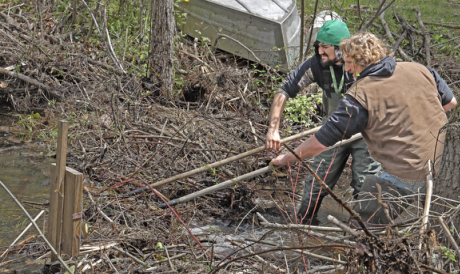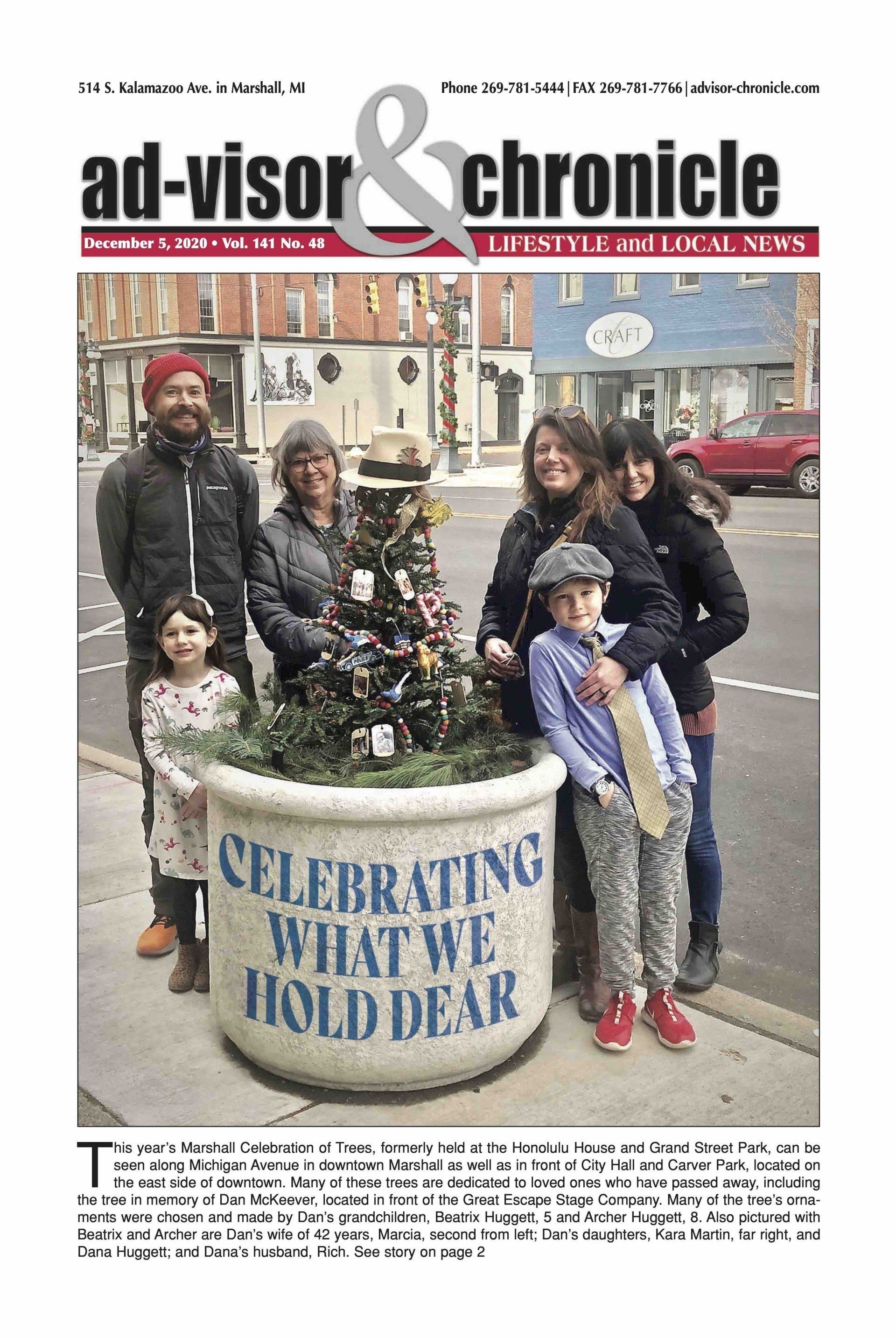Saxons, Trojans and Vikings win on home turf
Brett Bremer • October 3, 2020
Hastings 37, Pennfield 14
The Saxon offense compiled over 400 yard rushing and the Saxon defense shut out the Pennfield Panthers in the second half Friday.
The Hastings varsity football team improved to 2-1 on the season with a 37-14 win over visiting Pennfield in Interstate-8 Athletic Conference play.
Saxon backs TJ Russell and Keegan Olson each surpassed the 100-yard mark. Russel had 19 rushes for 177 yards and three touchdowns. Olson carried the ball 14 times for 11 yards. The Saxons also got 12 carries for 84 yards from Dan Harp.
Hastings quarterback Mason Denton added two rushing touchdowns of his own.
Denton had two short touchdown runs in the second quarter to turn an 8-6 Saxon lead into a 22-6 advantage.
Russell scored the game's opening points on an eight-yard touchdown run, and then added the two-point conversion himself.
Pennfield answered with a three-yard touchdown run by Cody Hultink before the end of the quarter to get within 8-6.
The Panthers managed to answer the two Denton touchdowns with one of their own in the final minute of the first half. Ryne Petersen scored on a four-yard run to make it an eight-point ballgame at the half with the help of a two point pass from Petersen to Luke Davis.
Russell touchdown runs of 13 yards and 28 yards were the only touchdowns of the second half. Harp added a two-point run after Russell's third quarter TD run, and Kaiden Shumway followed Russell's final score with an extra-point kick.
Robby Slaughter led the Saxon defense with nine total tackles. Russell had 6.5 tackles and Zach Perry and Drew Gleeson had 3.5 tackles each. Russell made three tackles in the Panther backfield in the contest.
Hastings' Matt Thompson and Collin Livingston each intercepted a Petersen pass in the fourth quarter.
Petersen was 12-of-25 passing for 196 yards, and he also led the Pennfield defense with ten tackles. Hultink was Pennfield's leading rusher, carrying the ball eight times for 23 yards. Luke Davis had five receptions for 69 yards for Pennfield and Shawn Gardner hauled in two grabs for 54 yards.
Hastings goes on the road to face Jackson Northwest next Friday.
Thornapple Kellogg 42, Wayland 28
There were times when things looked better on the scoreboard than they did on the field, but the Thornapple Kellogg varsity football team scored its first victory of the season in its first home game Friday.
The Trojans improved to 1-2 in the OK Gold Conference this fall with a 42-28 win over visiting Wayland, their third consecutive victory over the Wildcats.
Thornapple Kellogg scored a touchdown at the end of each of its first four possessions. The Trojan defense forced two punts, a turnover on downs and Matthew Middleton picked off a Wildcat pass on Wayland's first four offensive possessions.
On the Trojans' first snap after Middleton's interception, Trojan senior quarterback Reese Garbrecht connected with senior Alex Bonnema on a 45-yard touchdown pass to push the Trojan lead to 28-0.
The Wildcats got within two touchdowns a couple of times in the second half as the Trojans lost a pair of fumbles and were flagged 11 times for 115 yards including a handful of 15-yard personal foul infractions. That was the difference between playing with a running clock and playing under a little pressure.
Garbrecht completed his only two pass attempts for 54 yards and the one touchdown and also did a masterful job of running his team's triple option offense on the night. He rushed for one score himself. Mitchell
Middleton, the Trojan fullback, had a team high 15 rushes for 203 yards and a touchdown. Ryan Holmes added ten carries for 123 yards and three scores. Samuel McKeown chipped in seven rushes for 88 yards.
Garbrecht drew some gasps from the sideline and the parents in the stands when he fired a pitch to his left after charging a few yards upfield on the first play of a Trojan drive that started at their own 19-yard-line with a little over six minutes to go in the game. The ball fluttered into the arms of McKeown who kept charging ahead for a 24-yard gain. After a couple Garbrect runs and a handful by Mitchell Middleton the Trojans were in the end zone for the final time on the night – extending their lead to 42-21 on a one-yard run by the Trojan fullback.
Garbrecht said confidence in the pitch was key to his own success this week.
“He is growing every week,” TK head coach Jeff Dock said of Garbrecht. “We ran all three phases of it. When you can run all three phases of the triple, that's good stuff. I was proud of all of them on how they competed, even when it started getting a little edgy, everyone kind of regrouped and got back to execution. That was good.”
TK got a five-yard touchdown run from Holmes and a one-yard TD run from Garbrecht in the opening quarter to take a 14-0 lead. Holmes added a 12-yard touchdown run a minute and a half into the second quarter to extend the Trojan lead to 21-0.
Bonnema's touchdown made it a four touchdown lead for TK, but the Wildcats got some life on their final drive. A pass interference penalty and three personal foul penalties against the Trojans helped the Wildcats put together a 65-yard drive that ended with a one-yard touchdown run by quarterback Justin Holtz with two seconds to go in the first half.
Holtz also finsihed off the Wildcats' first drive of the second half with a 15-yard touchdown run after a Trojan fumble gave his team the ball at midfield.
Holmes answered for TK three plays alter with a 55-yard touchdown run. He took his time following McKeown up the right side. McKeown leveled one defender with a block and Holmes stepped through the tackle of another as he crossed over the 20-yard-line on his way in for the score.
Wayland back-up quarterback Dustin Loomans filled in for a shaken up Holtz momentarily on the Wildcats' ensuing drive, scoring on a one-yard run up the middle to get his team within 35-21 with 2:43 to go in the third quarter.
The Wildcats blocked a Mitchell Middleton field goal attempt after a long drive early in the fourth quarter, but the Trojan defense forced a quick punt and the TK offense went back the other way quickly thanks to Middleton who broke loose for a 45 yard run to the Wildcat one-yard-line and then scored from a yard out on the next play with 3:16 to go in the fourth quarter.
Wayland tacked on a six-yard touchdown pass from Holtz to Dustin Simmons with 1:49 to go in the game, but the Wildcats narrowly missed recovering an on-side kick and the Trojans were kneeled out the victory.
“It was great to get us back on track to what we want the season to be,” Garbrecht said. “We already have the automatic spot in the playoffs, but we'd like to get a little further than we have been in recent years.”
The Wildcat quarterback, Holtz, found a little more room to run in the second half against the Trojan defense. He finished the night with 24 rushes for 93 yards and two touchdowns. He also connected on 15-of-28 pass attempts for 188 yards and a touchdown. Simmons had five receptions for 93 yards.
Holmes led the TK defense with 8.5 tackles. Bonnema had seven and Carsen Burbridge had five tackles.
Lakewood 42, Stockbridge 26
Nick Helt returned the opening kickoff 72 yards for a touchdown and things kept going right for the Lakewood varsity football team Friday night at Stockbridge.
The Lakewood team improved to 2-1 overall this season and 2-0 in the Greater Lansing Activities Conference with a 42-26 win over the host Panthers.
The Vikings built a 22-0 lead and had a 22-6 advantage at the half. Lakewood had a double digit advantage throughout the entire second half.
“We finished drives tonight,” Lakewood head coach Matt Markwart said. “In the past we didn't. We did have two early on we didn't finish, inside the 20, after that we started finishing drives. We responded after they scored. We'd score right away on the next play. Our kids stepped up to the adversity.”
Garrett Stank rushed 15 times for 173 yards and two touchdowns in the ballgame. He scored on a 50-yard run quickly after Stockbridge scored the opening touchdown of the second half.
The Vikings also got touchdown runs from Sawyer Stoepker, Brent Sweet and Denny Sauers. Stoepker had six rushes for 62 yards in the game. Sweet rushed nine times for 58 yards. Sauers had seven carries for 43 yards.
“We started opening the holes, getting to our assignments, didn't make the little mistakes when we were moving the ball,” Markwart said of the offensive improvements Friday. “We started getting to our blocks and started getting to the backers.”
Defensively, things went pretty much as planned for the Vikings. The defensive ends were able to contain the Panther QB for much of the evening. Lakewood wanted him to throw and and paid off to the tune of five interceptions.
Stoepker led the way with three of them. He also forced a fumble. Stank and Helt had the Vikings' other interceptions. Sweet picked up the fumble Stoepker forced. Markwart thought his team could have had as many as nine interceptions.
Markwart said most of his defensive backs who have had him as a high school football coach now for four years hear it a lot, “if you get deep they throw you presents.”
“They had a good running quarterback and we wanted to keep him in the box and make him throw the ball. We knew we had a good chance of picking him off,” Markwart said.
He added, “our guys are fast, can close on the ball and they do their jobs really well. That's the biggest thing.
They're in position. They still make mistakes, but there are very few of them. They really do their jobs.”
Nathan Willette had a team-high eight tackles for the Viking defense.
Next up for the Vikings is the annual battle for the Greater Lansing Activities Conference lead with rival Olivet. The Eagles play host Oct. 9. They are currently 2-0 in the GLAC as well, and 3-0 overall after a 28-14 non-conference win over visiting Charlotte Friday (Oct. 2).
Martin 64, Maple Valley 18
The Lions were six inches short at the end of the first half, and wound up suffering through a long second half.
The Martin varsity 8-player football team scored a 64-18 win over visiting Maple Valley Friday night, dropping the Lions' record to 1-2 on the season.
Maple Valley led the ball game 6-0 and a after a few big plays by the Clippers still had the chance to go into the half tied at 20-20, but had a fourth-and-goal run come up just shy of the goal-line. As injuries mounted in the second half the Lions couldn't slow down the Martin attack.
The Clippers outscored the Lions 44-6 over the final two quarters.
Even missing time because of an injury, Lion running back Hugheston Heckathorn managed 27 carries for 123 yards and two touchdowns. Those touchdowns both came in the first half, on runs of five and nine yards.
Heckathorn's five-yard touchdown run capped a nice, long opening drive for the Lions and put his team ahead 6-0 five minutes into the ballgame.
The lead didn't last. Martin's Karter Ribble returned the Lions' ensuing kick 73 yards for a touchdown and then the Clippers got another quick score on a 20-yard touchdown pass from Gabe Meyers to Charley Martin.
Heckathorn's second touchdown run, fourth minutes into the second quarter, pulled the Lions within 13-12 at the time.
Martin had an answer again though, getting a 20-yard touchdown run by Brayden Eckman minutes later go to ahead 20-12 – a lead that lasted into the third quarter.
“We were picking blitzes and getting off the ball,” Lion head coach Marty Martin said of the first half effort. “Blaze did a masterful job of doing what he is supposed to do and Hugheston was doing what he was supposed to do. We did a nice job of keeping them off balance. We were wearing on them. There were times in the first half where they were subbing people in because we were wearing on them.”
In the end it was the Lions who were worn down. Martin said his team lost a defensive end to an injury, then a linebacker, then the back-up linebacker, and then another end.
The Clippers got a 63-yard touchdown pass form Meyers to JR Hildebrandt, a 10-yard touchdown run by Eckman, a 62-yard touchdown run by Meyers, a 35-yard touchdown run by Tuinstra and a 15-yard touchdown run by Bryce Robinson in the second half.
Jessy Deppe picked up a Martin fumble to start the second half, but the Lions couldn't cut into the Clipper lead at the time. Deppe also picked up a Lion fumble later in that third quarter. Tyler Rose broke loose on a 21-yard run only to lose his grip on the football. Deppe scooped it up and ran 55 yards for a touchdown – his team's only touchdown of the second half.
Martin outgained the Lions 530 yards to 300 in the ballgame. Meyers had eight rushes for 102 yards to go with 83 yards passing. The Clippers also had Tuinstra rush four times for 93 yards and three times for 87 yards.
The Lions got four carries for 46 yards from Amon Smith and 14 rushes by quarterback Blaze Sensiba for 46 yards. Deppe led the Lion defense with eight tackles. Smith and Sensiba had three each.
“I was proud of the kids,” coach Martin said. “They didn't ever stop fighting.”
The Lions will play host to another tough foe, Merrill, Oct. 9. Coach Martin sees Merrill as a big, physical ball club, kind of like the Whittemore-Prescott team the Lions faced in the first weekend of the season.
Jenison 28, Caledonia 14
Jenison outgained the Caledonia varsity football team by more than 200 yards on the ground and ground its way to a 28-14 win over the visiting Fighting Scots Friday.
The Wildcats had three guys go over 60 yards rushing on the night, including Kaden Bucholz who had 16 carries for 90 yards and Caleb Dean who had six carries for 64 yards and two touchdowns.
Jenison quarterback Jaden Vandalsen also rushed 22 times for 67 yards and a touchdown while completing two passes for 71 total yards and another touchdown.
The Wildcats never trailed in the ballgame. They built a 21-7 lead midway through the third quarter on Vandalsen's 64-yard touchdown pass to Dean. Dean already had a 21-yard touchdown run in the closing minutes of the first half, and he added a seven-yard touchdown run with 7:34 to go in the ballgame.
Vandalsen scored the first points of the game on a three-yard touchdown run ten minutes into the contest.
Caledonia sophomore pulled his team back to even with a 13-yard touchdown pass to Nicholas Fox with 5:33 to go in the first half, but Jenison answered right back with Dean's first TD run to go into the half up 14-7.
Jenison kicker Nate Ross was a perfect four-for-four on his extra-point kicks. Caledonia kicker Paul Voegler hit both of his P.A.T.s.
Carson VanderHoff got the Scots back within a touchdown by scoring on an eight-yard run with 1:28 to go in the third quarter.
VanderHoff finished the night with 21 rushes for 74 yards. McKenzie was 15-of-29 passing for 176 yards. He was intercepted once. Justice Reed had a team-high six receptions for 25 yards. Fox had four catches for 81 yards.
Caledonia will play host to Hudsonville Oct. 9.
Lawton 31, Delton Kellogg 7
Lawton intercepted the Panthers twice in the second half as it shut out the Delton Kellogg varsity football team over the final two quarters Friday to score a 31-7 Southwestern Athletic Conference Valley Division win in Delton.
Carter Cosby had touchdown runs of four and 13 yards for the Blue Devils, and Landon Motter and Jake Rueff each had a short touchdown run as their team dropped the Delton Kellogg team to 1-2 overall this season.
Lawton got the first big bounce of the game, recovering an on-side kick on the opening kickoff, but the Panthers' Vinnie Quick managed to thwart that Blue Devil drive with an interception.
The game was scoreless until the two teams began trading touchdowns late in the half. Hunter Belew pulled the Panthers back even with a four-yard touchdown run that was accompanied by an extra-point kick from Gavin Houtkooper.
The Lawton defense ended two Delton Kellogg drives with interceptions in the second half, forced the Panthers to punt once and got a turnover on downs. DK had five possessions in the second half. The last one ended in the clock running out.
Blue Devil kicker Ethan O'Donnel was a perfect 4-of-4 on extra-point kicks and added a 23-yard field goal late in the fourth quarter.
Belew and Caden Ferris had three tackles each for Delton Kellogg, with each guy recording a sack.

Jim Dull stands in the creek, waist-high in water, raking at a dam. He yanks out tree branches, moss, mud, leaves and more branches. Everything is entangled, intertwined and wedged together, strong enough to hold back a stream and flood a local resident’s yard. But from the instant he starts to rake, the dam comes apart and the water starts to flow. Dull almost seems disappointed. “They didn’t do a good job,” he says. He's talking about beavers. This dam near Coburn Rd off of M-37 in Hastings Township took just five minutes to disassemble. It must have been some younger beavers, Dull says. A good dam, one made by the mother and father, could take 30 minutes of ripping and pulling and tearing to break apart. “Man, you gotta appreciate it,” Dull says. “Anybody that is as ambitious as they are. How many people do you know work all night long to get something built? I know a lot of people that don't work at all.” After years as an excavator, homebuilder and county commissioner of District 7 in southeastern Barry County, Dull took over as drain commissioner in 2016. And, when he started, people kept calling him about beavers. A beaver's in the backyard, they would say. It had clogged up the drain and the road was flooded. Dull had to learn about beavers quickly. As drain commissioner, he has to clear every dam that clogs a county drain – in a county with nearly 330 lakes, he says. Even if it’s not a county drain, if someone calls and needs help clearing a dam, the drain commissioner will go out and clear the dam. “We try our damnedest to try,” he says. Dull doesn’t deal with just a beaver here or there. During the peak months in the spring and fall, he deals with them on a daily basis. Last year, the drain commission team caught nearly 30 beavers. If they don’t trap them, Dull says, the beavers will come back the next day and the next day and the next day. But Dull doesn’t mind it. He couldn’t imagine working a desk job. He forces himself to spend 8 a.m. to 9 a.m. in the office every day and then he’s out. He’s out looking at drains, answering calls on his flip phone, driving through the county with paper maps and dealing with the beavers. His truck is littered with equipment he might need on the road – scissors, bug spray, jackets, a deflated fitness ball, camouflage boots, black boots, a lunch cooler, rope and a discarded chocolate chip granola bar wrapper. “It beats the hell out being in the office,” he says. When Dull finishes clearing the dam, he walks out of the chilly October water in boot-foot waders with a smile on his face. “Ain’t it pretty out here?” he asks, giggling. “This is a perfect job.” Dull’s work with the beaver dam is done. Now it’s time to trap. *** Hanging up on the wall of his garage, Earl Craven keeps a list of the 90-plus beavers he has trapped for Jim Dull. He documents each catch with a tally on the paper, a picture on his phone and a thumbtack of the location on his Barry County map. But being good at trapping comes with a price: The beavers are killed. It’s part of the reason Craven says he hesitated about doing the interview in the first place. He doesn’t want people to misunderstand. “I'm not an evil person, I don’t want to be perceived that way,” Craven explains. “I’m a man doing a job who is very blessed; who has much compassion for the animal, you know?” Craven started working with beavers within the last 10 years when a friend needed someone to clear a beaver dam in his backyard. But he had never trapped one before, even as kid in Nashville. The beavers didn’t go easy. They buried some of his traps and avoided others. It took six weeks to catch those two beavers – six weeks of going back and forth to the same dam every single day. Craven laughs when he thinks about his first assignment. He can’t believe how long it took him. But, when he finished the job, he knew he wanted to keep beaver trapping. “I couldn't wait for the next chance to do it,” he remembers. Word spread. His buddy told someone else who told someone else: Earl Craven traps beavers. In the meantime, Craven was learning more. He got his damage and nuisance control permit from the Michigan Department of Natural Resources. He joined Facebook groups with beaver trappers. He made friends across the country, in Vermont, Wisconsin and Pennsylvania. He watched YouTube videos. He “hit pay dirt” on a beaver-catching DVD that changed his whole outlook on the operation. He started a business, Easy E Trapping. Around 2019, Craven got the part-time job with the drain commission as its beaver trapper. When Dull clears the dams, it lures back the beavers, who want to rebuild their creation. Craven will then place a trap near the destroyed dam, baiting them one by one. He will check on the traps every day until seven days pass without finding a dead beaver. Sometimes it can take weeks of clearing the dams and trapping the beavers to fully clear an area. Even then, the beavers might come back and start all over again. Craven sets up a Bridger #5 trap in his garage in the city of Hastings. He won’t share all of his tricks. Some stuff is on the record, some stuff is off. But he’s willing to show that it works. He kneels down on the concrete floor and props up a rod. He chains a foothold trap to the rod so that it dangles down in the air. Normally, the trap would be hidden underwater, with a piece of the rod and pink tape sticking out from the top of the water. It’s a small trap, the size of a bowl, with a pedal-looking feature in the middle. But, when it snaps, it’s strong enough to break Craven’s finger. Craven must bait the beaver into stepping exactly on the pedal. Then the clasp will snap on its foot and the beaver will sink down the rod, into the water and drown. When Craven cannot see the pink tape anymore, he knows he has caught a beaver. He's still experimenting with his trapping methods. He's trying out a new rod and he even bought a trap that looks more like a rectangular dog-crate. With this trap, if he catches another animal, like an otter or a turtle, he can let them go without harming them. “I ain’t getting rich off this. I ain’t making a whole lot of money at all,” Craven says. “I do it because I enjoy it. I enjoy the trapping, the cat-and-mouse. It's an old tradition nobody does.” Killing beavers, though, has an effect on the ecosystem and it isn't inconsequential. Actually, it's quite the opposite. They’re considered a keystone species. “They're essential in creating these wetland spaces,” says Mary Parr, stewardship manager at Pierce Cedar Creek Institute. “And so that's kind of what makes them a keystone to that ecosystem. In their absence, you know, none of that would exist.” The beavers aren’t building the dams to be a nuisance or flood roads. Instead, Parr says, they’re “creating wetlands where there were no wetlands previously.” The beavers literally fly underwater, carrying logs the size of their body weight in their mouths, breathing through a second lip. They will fill all of the holes in the dam with wood before using mud to “plaster” the structure, Parr says. But Parr also calls them “big meatballs.” On land, they are vulnerable to predators. Under water, where they can use their webbed feet and hold their breathe for 15 minutes, they feel safe. In turn, they also create habitat for a number of animals, like waterfowl, muskrats, otters, minks, toads, frogs, salamanders and fish. It provides a place for ducks and geese to park overnight as they migrate. “In a time of climate change, when a lot of wetlands might not have existed as they did previously, those habitats are going to be essential for dispersal of species as they're moving north into the climate range that fits their suite of skills,” Parr says. But there’s a conflict. “They prefer the same regions that humans do," she says. That means flooded roads, yards, houses and drains. And that means Jim Dull gets a lot of phone calls from people in Barry County needing help. *** Some days, Dull estimates, he receives two phone calls. On other days, he’ll get 40. Either way, the phone calls don’t bother him. He always tries to answer his phone and, if he doesn’t, he will call back. “I got a pet peeve about that,” he says. “I don't like to call somebody not to get a response. So I try to call them within less than a day. … You're gonna call me, you probably got a reason that you want answered.” Dull gives everyone his cell phone number and he rarely takes a day off. His wife likes taking trips across the country, but not Dull. He doesn’t like leaving work and he doesn’t like leaving Barry County. “I’m just tickled to death to be here,” he said. When someone calls him, he wants to be able to call back and do something about it. “The more exposure we get, the more people will know what we're doing,” Dull says. “If they have beaver dams, they'll know enough to call us.” They’re not trapping beavers for fun, Dull emphasizes. They’re trapping because some beavers need to be trapped. “I don't care for trapping because I don't like to kill things,” he says. Craven calls it “management.” And he follows a strict code. He does everything he can to avoid having to kill a beaver. He will only take necessary jobs, he said, like when a road or home is flooded. “I don't get a call from the road commission because some guy’s got a beaver eating his tree,” he says. When it's beaver season, November through April 2022, Craven can skin or eat the beaver. If they’re going to die, he tries to get the most out of the animal. “I don't get no glory out of killing anything,” he says. “Much respect to them; I try to use anything I can off of it.” But there’s not much more the drain commission can do as far as dealing with beavers, Craven and Dull say. If a beaver is causing a safety hazard for humans, it has to go. Relocation of the beavers is not a good idea, Dull says. Beavers are territorial and, when they enter the haunts of another beaver, the result is often bloody and violent. Even if Craven does move the beavers, he’s just “relocating a problem,” Craven adds. Trapping is their best option. And that’s a testament to the beaver, Craven says – his favorite animal. “If they build that dam and you go tear it out, they will build it again tonight,” Craven says. “If you tear it out, they will build it again the next night. “You will not win.”

Amy Henney-Planck can’t seem to sleep these days. Sometimes she sits in bed at 2 a.m. and just stares at the ceiling. Sometimes she gets up at 6 a.m. opens her laptop and does research. But the one thing she doesn’t do much is sleep. Henney-Planck owns an in-home medical care business, A Moment in Time. She takes care of Jesus Arias, who was in a near-fatal car accident 30 years ago and needs 24/7 care. The problem is, Henney-Planck can no longer afford to continue caring for him. And without her support, it’s unclear what will happen to Arias. Before this summer, Michigan’s no-fault auto insurance law allowed people who suffered serious injuries in vehicle accidents to receive 100-percent reimbursement for their medical costs. That changed after July 1. In an effort to lower some of the highest auto insurance rates in the nation, the state Legislature slashed reimbursement rates by 45 percent. Reforms did lower car insurance rates for most people, but they also cut deeply into the profit margins for caregiving companies, like Henney-Planck. According to the Michigan Brain Injury Provider Council, nearly 700 people in the state have lost this kind of care and at least 1,529 health care providers have lost their jobs. “I lay in bed, and I just think – how much longer can I do this?” Henney-Planck said. “What are [Arias] and his family going to do if we have to pull out? “My brain just doesn’t shut down.” The life Jesus Arias lives Jesus Arias, 68, is wearing a blue, green and yellow patterned bib as he sits at a wooden dining room table. He looks out of the window where the trees line the backyard of his home in Hastings Charter Township. He can’t move much more than turn his head, blink his eyes and say a few words. So he waits patiently for his caregiver Joanna Eckhoff to bring bites of a turkey wrap and Ritz crackers to his mouth. There isn’t a lot of talking at the lunch table. The hourlong lunch periods are intentionally quiet. Arias has to chew small pieces of food and take his time eating to make sure the meal goes down the right path. He's what they call a silent aspirator. Any distraction could disrupt his digestion, sending food spiraling into his lungs. When his daughter left without saying goodbye, for example, Arias turned his head and tried to speak. But he hadn’t finished swallowing his food and erupted into a coughing fit that sent saliva running down his chin and Eckhoff reaching for a roll of paper towels. It was a long – but successful – morning of physical therapy for Jesse, as they affectionally call him. He stood up in his standing frame for 30 minutes – the most he has accomplished since his injury 30 years ago. It’s a cause for celebration and good thing the first activity after lunch is “Jesse’s Time.” Arias lives a regimented lifestyle with his daily schedule marked down to the hour. Wake up at 6:30 a.m. Physical therapy at 9 a.m. Lunch at noon and then “Jesse's Time” after, which could include picking a Western movie from his shelf full of CDs, playing poker or watching horses. He hopes one day to ride a horse, but, first, he needs to work on his core, Eckhoff says. Arias signals he is ready to watch one of his favorite TV shows, “Two and a Half Men,” by picking up his favorite hat – the one with the emblem of Mexico on the front -- from the dining room table. He brings it to his head, but can’t put it on. Eckhoff reaches over to help. Then they’re off, with Eckhoff pushing his wheelchair, to his two rooms in the back of the house, which is equipped with a hospital bed, floor space for his physical therapy equipment and a couch for his caregivers. In 1988, Arias and his mother were driving back to Michigan from his father’s funeral in Mexico. Fourteen hours from home, the car hit a patch of black ice on a bridge in Oklahoma City. The car spun out and catapulted backward into a telephone pole. As the pole came crashing down on the car, Arias threw his body over his mother, saving her life. But the pole smashed into his head. Arias spent the next two months in a coma. It was unclear whether he would live or die. He never fully recovered. For more than 25 years, he stayed at Spectrum Neuro and Rehabilitation facility. A staff of full-time nurses took care of him around the clock. His medical costs were covered by the state’s no-fault auto insurance law. Then, in 2016, Arias nearly died in the hospital. He was septic and developed pneumonia. His sodium levels reached dangerous levels and his urine turned black. His condition eventually improved, but his daughter, Julia Arias-Pease, wanted him home in Hastings, where she could see him and help take care of him. She reached out to Henney-Planck, who brought on nine caregivers for Arias. Everyone noticed an immediate improvement in her dad In the hospital facility, he was like a “medicated zombie,” his granddaughter Hayden Thompson said. But under the care of A Moment in Time, he started to hold short conversations. He went from being diabetic to losing 170 pounds. He switched from 30 medications a day to just two – a blood pressure pill and an allergy pill. “He has more personality than I’ve ever seen,” said Thompson, who grew up visiting him in the hospital. Everything was paid for – from the home health-care workers to her father’s van to the doctor’s appointments to the two-room addition built at their house to accommodate Arias. Michigan Brain Injury Provider Council Board President Tom Judd called it “the best system of care in the country for auto accident victims.” The costs of keeping Arias alive haven’t gone away. He has improved with full-time home care, although not enough to live on his own. Physically, Arias-Pease compares him to a toddler. “He can't do anything for himself but probably itch his eye,” Arias-Pease said. “... So you literally are doing everything.” Gov. Gretchen Whitmer signed the Michigan no-fault reform bills in May 2019, but Arias-Pease wasn’t worried. She thought her family would be grandfathered into the system. Two years later, the law went into effect and that was not the case. In-home care providers, including Henney-Planck, had their reimbursement rates cut from 100 percent to 55 percent. State Rep. Julie Calley, R-Portland, who voted for the bill, said that the Legislature assumed 55 percent would be enough to support caregivers. Although Calley said she was not involved in the “tough negotiations,” she heard from leadership on the issue that, at the time, they had not received enough “openness” from providers to find a more exact reimbursement rate. “We thought that percentage was sustainable for long-term care providers, otherwise we wouldn't have passed it,” Calley said. “So it continues to be the intent that those who are grandfathered in will be taken care of. But since it has been raised that that may not be an accurate or sufficient reimbursement rate, now we need to figure out a change.” 'Would our legislators take a 45-percent pay cut?' Henney-Planck has owned her in-home medical care business for four years. Before the law went into effect, her insurance company, AAA, paid for her to treat Arias. Her business was reimbursed at a rate of $24 an hour to provide the care. Then she would divvy up $19 to $20 an hour to pay her caregivers and cover the overhead, which includes her own insurance and other liability costs. It left her with about $4 to $5 an hour for herself. She never made a lot, but she stuck with it and had plans to request more money. Henney-Planck has 13 other clients, all of whom pay out of pocket. Arias was the only family who paid for his care out of the insurance coverage. Now, continuing to care for Arias is setting back her entire business, but she can’t bring herself to leave him and his family. “I’m having the hope and the faith that this is going to get worked out,” Henney-Planck said. “… I cannot just walk away from him because I know there is not another agency that’s going to come in and accept 55 percent. So I have done what I could do and made the adjustments that I needed to stay there for a short time before what I have is gone.” Since the changes in the no-fault auto insurance law, Henney-Planck’s company gets reimbursed at a rate of $13.69 an hour for each worker she sends to help Arias. That cumulative loss of $10.31 an hour is taking a toll in more ways than one. Every hour she devotes to the care of Arias represents a financial loss that her business is having to absorb. She has lost four of Arias’ caregivers and doesn’t know how much longer she can absorb so much of the cost of caring for him. The law created a “fee schedule” separating services that Medicare and non-Medicare payable codes could cover. That affected caregivers like Henney-Planck. For Medicare payable services, such as physical therapy, speech therapy, physicians and nurses, people can receive reimbursement up to 200 percent. But for non-Medicare payable services, such as in-home services and residential care, reimbursement rates were cut by 45 percent. “It's not reasonable to assume that companies could have withstood that type of reimbursement cuts,” Michigan Brain Injury Provider Council's Judd said, “so what you see is these care providers have no other option than to either close their doors completely … [or] they're discharging their auto-funded patients because they simply can't work at that rate.” And that’s if the providers are getting paid at all. Between July 2 and Aug. 18, Henney-Planck’s requests for reimbursements, even at the reduced rate, were flat-out denied by the insurance company, meaning she had no money coming in from the insurance companies to cover Arias’ care. She made countless phone calls to her insurance company, the Michigan Catastrophic Claims Association and the Department of Insurance and Financial Services (DIFS), but it took more than a month to begin receiving payments again. Henney-Planck is not alone. Since the passage of the reform, Judd said he has heard of multiple instances where providers were not being paid. “The insurance companies have a lot of tools in their tool belt to deny and delay claims,” he said. “...It seems like a coordinated effort to kind of wait providers out and chill the post-acute continuum of care. Wait these providers out, they're not going to be able to stay in business and insurance companies and the [MCCA] are going to be off the hook for lifetime care.” People having trouble with the new insurance rates are encouraged to work out the issues with their insurance companies first, DIFS Director Anita Fox said. If that doesn’t work out, they can file a complaint with DIFS, the state agency that helps to regulate insurance companies. Fox said DIFS is like a “facilitator,” working between the service providers and the insurance companies. Since the law passed in early July, Fox said they have received about 60 complaints related to reimbursement rates. As of Sept. 10, a little more than half of those complaints had been resolved. “By resolved, I mean that there's a medically appropriate care plan in place that meets the family's needs and complies with the policy and the law,” she said. “Again, it may not be exactly what the family wanted.” In recent weeks, Henney-Planck's financial situation has improved slightly. She has started receiving checks from AAA, even though they have come in at the reduced rate. Arias-Pease's cousin set up a taco stand during the 28th Street Metro Cruise in Grand Rapids and contributed $1,700 to the $4,053 the Arias family has raised for Henney-Planck in a GoFundMe account. Still, Henney-Planck gives herself two months before she can no longer afford to treat Arias. She’s frustrated, confused and sleep-deprived. “Would our legislators, would all these insurance agents, would they take a 45-percent pay cut? Absolutely not,” Henney-Planck said. “But yet, I'm supposed to take a 45-percent pay cut?” If Henney-Planck can no longer afford to treat Arias, that means his daughter, Arias-Pease, would have to take care of her father 24/7. Arias-Pease, who has owned and run Creative Designs on State Street for 14 years, said she would have to close her business. And, if that happens, she gives her family only a month and half until their funds will run out. “We do nothing but cry,” Arias-Pease said, “nothing but cry.” Cleaning up the mess After people in Michigan lost their coverage, the state earmarked $25 million through the Licensing and Regulation Authority to compensate providers for their loss in reimbursement. Arias-Pease and Henney-Planck said they had trouble finding the form to become eligible for the additional support. They obtained the form only after Calley’s legislative aide emailed it to them. When they did receive the form, however, it was difficult to understand. The process requires providers to show how much money they requested, how much they received and documents that prove they cannot sustain their business on the amount they were given. But for people who haven’t received payments at all, they can’t even apply in the first place. When they do apply, the review process takes 21 days and another seven days after approval for payment – pushing up against the deadline Henney-Planck and Arias-Pease have set for themselves. At first, Henney-Planck tried filling out the form on her own, but got stuck after it wouldn't register her company. She contacted Calley's office and they connected her with someone from DIFS to walk her through the application. On Friday, Aug. 27, the Arias family showed up at Calley’s office hours at the Tyden Center. They told Calley their story and asked for her help. “People aren’t aware of what these other people are living and experiencing – and the hell they’re going through unless they are living it,” Henney-Planck said after the office hours. “And that's what we need to do – get it out there and make more people aware of it.” During the meeting, Calley recognized that the Legislature had overlooked the providers who had their pay cut by the reform. She pointed to the $25 million as a way to tide people over until they find a better solution. Calley said they will use the $25 million to “collect data.” Once that $25 million is given out, the Legislature will receive a report with the data from DIFS to inform the next steps. “When you enact large reforms like this, it’s not unusual to find that you need to make some changes thereafter,” Calley said. “We’re willing to do that; we just need to make sure that we're doing it the right way.” Calley did, however, maintain that parts of the new law have worked. The reforms have addressed fraud and waste abuse in the auto insurance industry, she said, one of her main concerns. “We were the last state to have this unlimited option out there without any sort of ways to rein in the expenses that insurance companies would then have to turn around and pay,” she said. Before the changes, car owners were required to choose unlimited coverage for Personal Injury Protection, which raised auto insurance rates across the state and discouraged some from buying insurance altogether. Now, people have the option to choose their coverage and Calley said she has received mostly positive feedback from her constituents. As a result of the reforms, Fox said rates have gone down across the state and at least 50,000 previously uninsured drivers have obtained auto insurance. Calley said she has heard of at least 26 new auto insurance agencies opening in Michigan. Plus, Calley added, there are consumer protections that disallow auto insurers from using factors such as marital status, gender, occupation and credit score to determine someone’s rate. But for Arias and his family, those details are superfluous. Without this financial support, his life is on the line. He's not in any condition to fight for it and that's the point. Fortunately for him, his family and care providers are fighting for him and they're asking the state Legislature to fix the reform. The time they have is running out. “It does need to happen now,” Arias-Pease said. “We can't wait.”

Hastings Public Library has an unusual life story. It can trace its origins back to the Hastings Women’s Club. It likely moved around in a few homes on or near Green Street in its youth before settling in above the old Banner….. office in its late teens. There it lingered for a bit before moseying over one block and finding a suitable room within the old city hall. Maturing into its 20s, but still in need of a home, it was taken in, adopted, by Hastings High School in 1918. The school was brand new and the city and school administration agreed to share custody. It grew and expanded with age, moving twice within the high school before cutting ties at 70 and setting out on its own as a public library in a former post office. There, too, it continued to grow, struggling to adapt after new technology began to emerge as the library neared the century mark. Where a coal cellar and fallout shelter had once had a place and purpose, micro-computers and the World Wide Web were moving in like young, uninvited guests. The thick walls and secure features of the old structure were not readily compatible with modems, cables and wiring. But the library wasn’t about to give in. Instead, it found a new home, equipped for patrons of all ages, and, like a kindly old grandpa, opened its arms to the community. After all, the community had long supported the library, which will mark 125 years at a special celebration Aug. 7. (See related story.) Origins with women’s club The Hastings Women’s Club had its first meeting in the parlor of the Green Street home of Emma Goodyear in October 1893. The members established some rules and some goals: The club would focus on both culture and service. Membership would be limited to 40 women from all areas and all denominations within the city. A library was among the early goals. Soon, members began to set aside money to go toward the purchase of books. After two years, they had raised $75 and placed an order. Mary Spencer, the state librarian, sent a box of books – some classics, a few travel books and some of the latest novels. Some books were donated by the community, as well. A bookcase was needed – and was promptly procured, establishing the first library in the city in 1896. Initially, though, it was limited to members of the women’s club, who were allowed to borrow books on alternate Fridays. While still under the proprietorship of the women’s club, by 1906, the expanded collection was set up in a room above the Banner ……office. The room was known as the Manufacturer’s Club, above what is now Seasonal Grille at the corner of State and Church streets. The next move for the growing collection was a room at the old city hall, at the corner of State and Broadway. As plans were being drawn up for a new high school in 1916 or 1917, school and city leaders decided to incorporate a library within the new building. Plans were completed, bricks were laid, and the women’s club voted to donate its collection – by then 500 books – to the enterprise. That iteration of the library was on an upper level in the original, east portion of the former high school, until 1955. According to a Nov. 21, 1996, Banner…… article by the late Joyce Weinbrecht, branch libraries were established in the ward schools within the school district. The hush, the stairs, the book Jane Arnold has special memories of that library on the east side of the school. She attended Central Elementary. Despite the close proximity, elementary students at that time didn’t visit the library as a group; it wasn’t big enough, she said. But she visited frequently on her own. “If you went in the front door there on the east end, you had to go up a whole bunch of stairs – that's all you could do if you stepped in the front door,” she recalled. It was basically one-room library, she said, the size of a large classroom, with children's books on one side and the adult books on the other. And in her random collection of childhood memories, she can picture a counter and, behind that, an off-limits area with lots of books. “Of course, I never got to go back there,” the former Jane Whitmore said. “I just remember there were stacks of books, and you had to ask a librarian to get those books back there. I don't know if they reference books there or whatever.” She was much more familiar with the children’s area. Getting to the shelves of children’s literature, though, could be intimidating. “I walked back and forth to school, and I would go over [to the library] maybe after school by myself,” she said, “and I’d go in and see all those stairs. And then I would hear these high schoolers up at the top of the stairs because they were in the rest of the building, and I was a little bit intimidated. But I’d get to the top of stairs and just quickly turn left to go in the library.” A very quiet library. “I do remember you could not talk. They would speak to you, if you talked. I remember that,” she said, adding that the librarian was Jean Barnes, who was “how you’d picture a librarian.” Arnold also remembers repeatedly checking out a particular book: “Madeleine.” “I don't know how many times I would check it out,” she said. “I loved that book, and I would check it out bring it home, and then I’d take it back later.” The library was moved to the lower level when the west addition, including a new gym, was added in 1955. When the library was moved to the former post office, that space was converted into administrative offices for the school district. Restlessness and parting of ways Miss Jean Barnes, a native of Hastings who held degrees from both the University of Chicago and the University of Michigan, was the first librarian, hired in 1921. She had returned to Hastings to care for her mother before the new position opened. She was well-qualified, the obvious choice, and would serve in that role for 31 years, retiring in 1952. Within the 10 years after Barnes retired, four different people served as the librarian, one of them, Henry C. French, taking the job twice and departing twice. George Early moved from New York State to fill the position in August 1958, but left after eight months to assume leadership at a library in Illinois that was not affiliated with a school system. In early 1963, Weinbrecht noted in her 1996 column, school maintenance staff made study booths thickly padded with acoustic tile. Students appreciated the privacy and reduced distraction the booths provided. Students, it seems, weren’t the only ones looking for separation. The idea of removing the public library from the school was growing with persistence, Weinbrecht wrote. She’d found an undated report given to the Hastings City Council, likely from the early 1960s. “The practice of uniting the facilities of public and school libraries was a popular one a number of years ago,” the report read. “A great many cities, large and small, were attracted to the obvious money savings involved. The money was saved, but the experience in all cases proved unsatisfactory. “The unfortunate truth of the matter is that such libraries became, over a period of time, more and more devoted to the needs of the school. Service to the general public must be maintained, but that public will not take full advantage of service under such circumstances. … Most communities have abandoned the combined libraries system because of the poor experience. “… The presence of 30 or 40 children in the library makes a difficult atmosphere for most adults, and the 5 percent use [among the adult population] in Hastings seems to substantiate this feeling.” The desire to part ways was not new. In 1950, a donor had given $100 toward a public library, hoping to rally the library card-carrying troops. In September 1951, the Banner ……. reported that the city council had accepted a gift of property at the corner of South Broadway and Center Street to be used for a public library. Paul Siegel, the city’s attorney, told the council that groups and individuals had raised money to purchase the property and to pay for it to be remodeled to serve as a library. Over the years, the library has been situated near one corner or another, but this, ultimately, was not one of its home corners. But the effort showed earnestness among the public. The article noted that the city had paid $5,200 toward the upkeep of the library the previous year, a little over half of the expenses. Alderman Lannes Kenfield, who also served on the library board, said that money could go toward a public library that could be open “at times more convenient to the public than the present institution.” Arloa Lathrop, widow of Dr. Clarence Lathrop, left money specifically for both Pennock Hospital and a new public library in 1954. That $15,000 donation toward a library was invested in bonds, and according to a Dec. 23, 1954, Banner ……. article, “at the end of 12 years, will be worth $21,025.” The feds get involved It took about 12 years before the library would move from the high school to the corner of Church and Court streets. Those were 12 busy years – with interest. The library was not just relocating, it was becoming a completely new entity. Although some books would be transferred from the high school, Hastings Public Library was still just an idea and had little in the way of possessions. The U.S. government moved the Hastings Post Office from Church to West Mill Street in 1963. The sturdy brick building seemed an ideal structure for a public library. The corner lot across from the stately courthouse was ideal. And it was vacant. The federal government agreed to lease the building to the city for $1 a year. Contracts were signed, remodeling plans sketched out, committees formed, campaigns launched, and donations for books and remodeling trickled in. The roof was replaced. The coal heating system was converted to gas. Oak tables and chairs were chosen, along with carpeting and floor covering. A Dec. 31, 1964, Banner …… article reported that at least an hour was needed to process, catalog and cross-reference each book. More than 50 people helped with the process, and their work totaled about 9,000 hours. Starting in July 1964, the school library was no longer accessible to the public. Finally, in mid-January 1965, the new city-owned public library was opened. The outdoor ceremony was brief because the air was brisk, hovering around zero degrees. The new library became an integral part of the city, drawing in patrons from throughout the county, hosting clubs and meetings, squeezing in 100 or more children for summer reading programs, adapting with technology, converting the old loading dock from the post office days into a youth literature area with a back entrance, moving the circulation desk, reconfiguring and rearranging – until it couldn’t shift anymore. Talk of a new library began. A district library was proposed, but that failed. Three specific sites, including the former Royal Coach building, were considered. Extensive research and site developments were studied before the library board was able to settle on the corner of State and Apple/Boltwood streets. Feeling lost Shortly after getting married, Larry and Judy Kensington joined a literary guild on the east side of the state. However, they soon realized that neither liked to read a book more than once, and they’d spent $200 or $300 on books they wouldn’t read again. Judy Kensington had been a library patron since she was 5, when her mother would take her to pick out books once a week. So, the young couple turned to the nearby Mount Clemens library. Because they didn’t reside within the city limits, they paid $100 a year for membership – still much less than purchasing new books. By the time the Kensingtons moved to Hastings around Thanksgiving 1983, Mount Clemens “had a state-of-the-art brand-new city library,” she said. The Hastings library had become a bit overloaded, and it was a letdown for Kensington when she first visited. “I just shook my head. ‘This isn’t going to work.’ The back porch [former loading dock] had turntables, and they were loaded with old paperbacks, not in order,” she said. “There was virtually a place for new books. I felt lost.” She began making weekly trips to a Kent County library to check out books for herself and her family. She eventually returned to the Hastings library after Barbara Schondelmayer was hired as head librarian, who provided better organization and started the campaign to build a new library. Kensington retired as a teller at Hastings City Bank in late December 1999 and immediately took on a new position. The library and bank were directly across from each other at the time. “I walked across the street the day after New Year’s 2000, and said, ‘I would like to volunteer.’ New corner location Initially, Kensington re-shelved children’s books every Tuesday and Friday. Now, she’s president of the Friends of Hastings Public Library group, volunteers wherever needed, is in charge of the shelvers and helps train others in that essential task. “If you put a book away wrong, it’s lost until somebody finds it,” she said simply. Kensington herself hasn’t felt lost since the new library opened in 2007. And she’s proud of the facility, too. “I think we have a wonderful library now. It’s warm, it’s friendly, and it’s the center of the city,” she said. “When new people move here, part of the reason they move here is because of the library.” She can quickly think of people who based their decision to move to Hastings mostly on the library. Hastings isn’t unique in that regard, though. She recalled a couple who were guest speakers a few years ago for Calvin University’s January Series, which is livestreamed at the Hastings library. The couple had traveled the country and written a book about small towns. “The small towns that are the most successful were the towns that had a thriving library,” she said, conveying the author-couple’s conclusion. “People look at schools and look at libraries, and now they look at the Thornapple Plaza ....” “And the fact that we built [the current library] with private funds says the whole community was behind having a new building,” she added. Still, she sometimes encounters people who haven’t visited the “new,” now 14-year-old, library. And that baffles her. She’s so familiar with the library now, she can easily list all sorts of services, items, and activities it provides. If nothing else, people should go to the library and see all the thriving things they have, she pointed out. As for the future of the library, Kensington said she sees it keeping up with technology. Back in the 1960s, when she and her late husband were in the literary guild, most people had wall phones. “And, if you were lucky, you had a 20-foot cord, so you could walk around the corner with it,” she said. Now, with smartphones, people can walk around any corner within the library and check out materials on their phones. She expects the library to keep up with technology. “They already have the latest things available,” she said of the Hastings library, adding that she’s looking forward to seeing the advances. Good move Jane Arnold describes the current building as a big asset to the city, noting that it took several years and a lot of effort by many people for the new library to be realized. About $6 million was raised, which was a decade-long struggle until the Barry Community Foundation and a generous anonymous donor stepped in to make the dream a reality. “It took a long time … people had to work really hard to get the money raised,” she said. “I don't remember all the people who worked so hard at it, but it was a good move. “It was a long time coming,” Arnold added. She and many others benefit from the larger facility and its ever-expanding offerings. “Our library today, I think it speaks well of Hastings. It has a lot to offer,” she said, pointing out the designated teens' and children’s sections, the community room, the numerous services and variety of materials. “I think they make it very easy for people to access, and they do other things to broaden people’s knowledge,” she said. “We thoroughly enjoyed the January Series livestream. “There are lots and lots of records down there, probably more than I realize,” she added. “Lots of research can be done down there if people are interested in history and so forth. So, yeah, I think it speaks very well of Hastings.”

As the career and technical education director at Hastings High School, Ed Domke gets a lot of phone calls. People call about wanting to volunteer. They call about tractor restoration projects. They call about donations. One day, nearly three years ago, he received a phone call about a farm in Delton from a man named Bob Gilmore. Gilmore didn’t say much over the phone. He said he owned a farm. He said he was thinking about donating some farmland –– and that was about it. Domke didn’t think much of it. “Can you come out?” Gilmore asked during the call. “I’d like to meet with you.” So, one day after school, Domke visited Gilmore and the property in question. For the next two to three hours, they hopped on Gilmore’s quad bikes and started cruising around the property. They passed by a pond, a lake with a campsite, a horse barn at the old fairgrounds, a wooded area maple trees, beef cattle and a creek. That's when Domke realized this wasn’t just any farm. “Looking at everything, it's just like, ‘Oh, my gosh, this is beautiful. This is an awesome opportunity,’” he said. Domke, who has taught at Hastings High School for 36 years, saw the possibility for learning. He envisioned agriculture students growing their own plants, taking care of their own cattle and maybe even making their own maple syrup. Science classes could run experiments back in the woods. Hastings FFA Alumni had never owned a farm before. At Hastings High School, agriculture teacher and FFA Advisor Andria Mayack would bring horses, hogs and trailers to the parking lot behind the high school where the students would work with them. If the FFA chapter wanted it, Gilmore told Domke, the farm was theirs. The farm was valued at $1.2 million and he didn’t want a dollar in return. That was in 2018. And after three long years packed with back-and-forth discussion, the farm is now the property of Hastings FFA Alumni. “I guess I still can’t believe this,” Domke said. *** Three years after Domke toured Gilmore’s farm, I turned on to Lammers Road in Delton and drove down a gravel road. The path swerved through a tunnel of trees for about five minutes. And then the trees disappeared. Suddenly they were replaced by an ocean of greenery –– 276 acres of grass, lakes, hay, cattle, farmland. I was at Gilmore's family farm, set to receive my own tour. On this day, he took me in his side-by-side Gator to see the property. We cruised at 5 mph, enjoying the 70-degree weather and the bright blue skies. This is Gilmore’s life now. He lives alone and still wakes up at 5 a.m. to drink coffee and watch the news. “The farmer thing,” he called it. But that’s about the only farmer thing he does on a regular basis now. Gilmore, 60, is retired. Although he has a lifetime lease on his house, the farm now belongs to the Hastings FFA Alumni. He oversees the farm, but these days, all he really has to worry about is taking care of his dog and planning fishing trips to his new place in Inverness, Fla. As we drive around the property, Gilmore points out all of the different nooks and crannies. It’s hard not to notice that Gilmore could have made more than a million if he had sold the farm. But he never wanted to sell it. “Money don’t mean s--- to me,” he said. “If it did, I would’ve sold it and been a millionaire and moved on. But I didn’t want to do it.” Instead, he wanted to donate it. He wanted the farm to remain in agricultural use, and that might not have been the case if he had sold it. “People would split this off,” he said. “There would be houses all over the … place. And I don't want that. We need farms. You go up to Caledonia? That's prime farmland. Look at all those houses out there now. I don't want that. I want this all natural.” When I asked why we need farms, he slowed the Gator to a crawl. Then he turned his head and looked me straight in the eye. “Why do we need farms?” he asked. “What are you going to eat?” Gilmore didn’t grow up on a farm, but farm life always was around him. He was raised in Corunna, just outside of Owosso. His father worked in a factory as a carpenter. His mother stayed at home and watched over their seven kids. He spent his free time roaming nearby farms –– often helping his neighbor or grandmother with their dairy farms. At about 14 or 15, he started visiting his aunt and uncle at the Delton farm they had bought in the 1960s. Toward the end of high school, he moved in with them permanently, graduating from Hastings High School and working on their farm. “I just love farming; it’s peaceful out there in the fields,” he said. “Just relaxing.” After high school, Gilmore took a job in Arizona, worked with deep-well irrigation pumps and lived there for eight years. Then he returned to Delton and hasn’t left since. “This is it, right here,” he said, driving through his farm. “This is it.” He built a house on Cloverdale Road, just minutes away from his aunt and uncle, and lived there for 27 years. He worked an assortment of jobs in the area before the deaths of his uncle 16 years ago and his aunt three years ago. When his aunt died, Gilmore sold his own house and moved to their farm. But Gilmore didn’t want the daily grind of farming his own 276 acres. That’s when he thought about donating it. Mayack first heard about the possible donation in the driveway at her house. She has known Gilmore for years –– her husband was a part owner of Bull Creek Veterinary Service, which Gilmore has used. In the driveway, Gilmore told her he was thinking about donating the farm to Michigan State University. Mayack went into pitch mode: Gilmore should consider local kids. He should consider the FFA. “I kind of pulled him and said: Think of us, you know, think of the opportunities,” she said. “And he got so excited.” Call Ed Domke at the school, Mayack told him, and they would be off and running. But there was nothing fast about the process. After speaking with Gilmore, Domke took it to the executive board of the Hastings FFA Alumni. “We were definitely shocked that someone was willing to do that,” Hastings FFA Alumni Secretary DeAnna Stanton said of her first reaction. “And we were a little scared about the amount of effort required to keep it up.” Then they had to get approval from Hope Township for the property's nonprofit classification. On top of that, Hastings FFA Alumni had to secure insurance and work out the legal details of the agreement with Gilmore. In addition to the lifetime lease, Gilmore, who serves as caretaker of the farm, still has the rights to the garage next to his house, the dead trees for firewood and full use of the lakes. (“No one owns the lakes. ... God owns the lakes –– that's my feelings,” he said.) Most important to Gilmore, though, is that no one can break up the 276 acres. That property must remain in one piece. The process to finalize the agreement required a multi-year roller coaster of legal discussions. “There's so much back and forth with these kinds of large agreements that you're like, ‘Is it ever going to be done?’” Stanton said. In October 2020, the two parties finally signed the insurance liability agreement, marking the end of a two-year-plus process. But that didn’t mean the deal took effect immediately. Because of COVID-19, the FFA was unable to get many of its kids up to the farm for a few months. “It was a little shaky putting it together this year, and maybe it would have been anyways, even without COVID, because this is all new to us,” Domke said. It's starting to change, slowly. Students began visiting the farm in May, growing pumpkins, sweet corn, soybeans and hay. Just last week, they hosted an awards banquet for the Hastings FFA and Hastings FFA Alumni in the barn. For many years, Hastings FFA members made do with what they had. Mayack would bring in cattle to the parking lots. Sometimes she would bring her students up to her own farm. But there 's only so much that can be done with limited resources. About six years ago, Edythe and Harold Marshall of Delton donated $330,000 for the construction of a barn right behind the high school. (The barn is currently under construction in hopes it will be finished before the 2021-22 school year.) Then came Gilmore's farm. Combined, the two additions will provide a range of resources that just weren’t previously possible. While the barn will provide a learning space right in the students' backyard, the farm presents a different world of opportunities. “[The barn] doesn't incorporate any cropland,” Domke said. “It doesn't incorporate any hardwood forest. And it doesn't have a lake and a creek.” But everything is not running perfectly just yet. They’re still trying to sort out how to use all of the different parts of the farm and determine who will manage what. They’re trying to figure out how and when to have students at the farm. They’re trying to decide which animals they want and what procedures they have to develop to keep kids safe. Domke stressed that it will take time to figure out how to most effectively use the farm. “I don't think we'll really see the full impact of this farm starting until this fall when the kids walk back in the door,” he said. “And it's probably going to be, I don't know, three to five years before everything is just kind of seamless.” Gilmore’s in no rush himself. He’s just happy to have his farm safe for the future. For years, Gilmore has watched mega-farming corporations tear through land around him. When he was growing up, a family farm, he said, could live off of a 40-cow operation. Now, a family farm needs 200 cows. The big corporations can milk out 1,000 cows. “It kills us small farmers. … It's the small farmers that built this country,” he said. “But it's not going to change. It'll never go back to small farms.” Gilmore knows there’s nothing he can do to stop that trend – but at least he can try. Donating his land is his defense of choice. He can help to equip the younger generation with farming skills, and he can stop people from dividing up his family’s land. And if this doesn’t work, he has a backup plan for his backup plan for his backup plan. He had it written up in the agreement that, if Hastings FFA Alumni doesn’t want the farm any more, it will go to the National FFA Alumni. And, if that national organization doesn't want it, it will go to Michigan State University. By any means necessary, the purpose of that property will remain agricultural –– and that’s what matters to Gilmore. Now that the donation is finalized, Gilmore can rest easy. As he drives down a gravel path back to his house, finished with his tour, he looks at the farmland. “You come back in 50 years –– it's gonna be just like this,” Gilmore said. “I won't be alive. So you come back in 50 years and check it.”
















